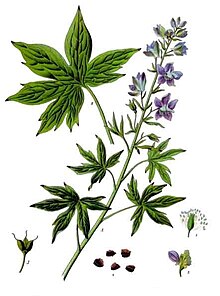Perennials
| URL | Description |
|---|---|
| Asiatic Lily | |
| Delphinium - Wikipedia | 
Delphinium is a genus of about 300 species of perennial flowering plants in the family Ranunculaceae, native throughout the Northern Hemisphere and also on the high mountains of tropical Africa. The common name "larkspur" is shared between perennial Delphinium species and annual species of the genus Consolida. Molecular data shows that Consolida, as well as another segregate genus, Aconitella, are both embedded in Delphinium. The name "delphinium" derives from the Latin for "dolphin", referring to the shape of the nectary. |
| Drought-Tolerant Garden Plan |  |
| Euphorbia x martinii - Ascot Rainbow | 
Euphorbia x martinii 'Ascot Rainbow' PP 21,401 (Ascot Rainbow Spurge) - An compact perennial that grows 24 to 30 inches tall by 20 to 24 inches wide with very distinctly variegated narrow 2 inch long leaves that are displayed as neatly-layered rosettes rising up on the many stems from the base of the plant. The foliage and lower flower bracts are a rich blue-green color edged with yellow-cream that dramatically flushes red with new growth in spring and again as temperatures cool in the fall and then holding this color through winter in our southern California gardens. The flowers which rise up just above the foliage in mid to late spring and last into summer have clusters of the typical compound euphorbia flowers, called cyathiums, which have chartreuse and yellow bracts with dark red staminate flowers at the base of the cup-like involucres. Plant in full sun in a well-drained soils and give moderate to occasional irrigation. Hardy to at least -10°F - it is doing well in gardens in USDA Zone 6 and being tested in Zone 5. It is quite pest free and not attractive to deer or rabbits. A great plant for containers, in the border or mixed with grasses as an accent in a meadow like setting. This plant is the result of the selection of a naturally occurring branch sport of an unpatented cultivar of Euphorbia.x.martinii (E. charachias x E. amygdaloides 'Rubra') that was discovered by David Glenn of Lambley Nursery in Ascot, Victoria Australia in 2005. It is similar to Euphorbia Helena's Blush but has a broader variegation and deeper red winter coloration. E. 'Ascot Rainbow' was winner of the Bronze Medal at the 2010 Plantarium and received its US Plant Patent on October 19, 2010. It is marketed in the US by PlantHaven. This description of this plant is based on our research and our observations of it growing at the nursery, in our own garden and in other gardens. We always appreciate receiving feedback of any kind from those who have any additional information about this plant, particularly if they disagree with what we have written or have additional cultural tips that would aid others growing Euphorbia 'Ascot Rainbow' PP21,401 . |
| Gaillardia - Wikipedia | 
Gaillardia the blanket flowers, is a genus of drought-tolerant annual and perennial plants from the sunflower family (Asteraceae), native to North and South America. It was named after M. Gaillard de Charentonneau, an 18th-century French magistrate who was a patron of botany. The common name refers to the inflorescence's resemblance to brightly patterned blankets made by native Americans. |
| Oriental Lily |  |
| Russian Sage | 
With its tall wispy wands of lavender or blue flowers and silvery foliage, Russian sage is an important player in summer and fall gardens. It shows off well against most flowers and provides an elegant look to flower borders. The aromatic leaves are oblong, deeply cut along the edges. Foot-long panicles of flowers bloom for many weeks. Excellent drainage and full sun are ideal, although very light shade is tolerated. Plant close to avoid staking since the tall plants tend to flop.
|
| Salvia |  |
| Sedum 'Elsie's Gold' | 
|
| Shasta Daisy | 
|